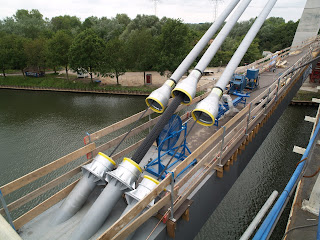The Muiderbrug (Muider bridge) is one of many steel bridges of which Rijkswaterstaat (Dutch Ministry of Transport and Public Works) has concluded that it does not comply to today's requirements anymore. Since 1970 traffic has grown in size and volume and hence the bridge

had to be strengthened. Simultaneously it was decided that the bridge would get dedicated rush hour lanes in order to improve traffic flow.
Besides road traffic, shipping wanted to increase clearance below the bridge to allow higher ships to pass the bridge.
To fulfill both wishes, the bridge will be elevated 20 cm at both pillars, while the abutments will remain at the original position. Subsequently the bridge will be lifted 50 cm more at the middle of the bridge. This will be done by connecting a cable stayed construction supported by 70 m high pylons at the middle of the bridge.
The first phase, the jacking up at the pillars, has been executed without interfering the traffic. The second phase will be executed end of June after the pylons have been erected and the cables have been installed partly.
To enable the execution of the second phase, 2 pylons will be built. The pylons consist of a foundation and a bottom part of the pylon, both made in situ, as well and a top part of 11 prefabricated segments of 5,1 m high each. End of May the prefabricated part of the pylons will be erected to 50 m high in one weekend. The top four segments, which will give the pylons their total length of 70 m, will be erected later. They will be added for ecstatic reasons only.
End of June the cables will be stressed to lift the bridge to its final position. Then it will become

clear if all extensive calculations which were part of the engineering, comply with reality. One of the most important items in these calculations was the stiffness of the existing bridge, because in spite of all advanced calculation methods used, it appeared difficult to determine. Preliminary measurements done by putting a load of 100 tons in the middle of the bridge have shown that the stiffness of the bridge will be about 20% higher then assumed during calculations. Because of this several calibration steps have been included during stressing of the cables. The installation and stressing of the cables will be adjusted according to the results of the measurements.
During the stressing of the cables the bridge will be closed once completely for 12 hours. This will be done when the cable-stayed construction is connected to the existing bridge. Vibrations must be reduced to a minimum at this moment to avoid damages. Because of traffic, the bridge is moving up and down about 2 cm.
When the project will be completed, it is the first time in The Netherlands that a steel girder bridge has been transformed into a cable stayed bridge. Moreover this will be achieved while interference with the ongoing traffic has been reduced to virtually zero. A unique project will be finished of which Royal Haskoning can be proud.

Engineering done by
Royal Haskoning: final and detailed design of the pylons (inclusive of erection), the cable anchorage construction on land and the foundations. The detailed design of the cable stayed construction has been engineered in cooperation with Greisch consultants located in Luik (Belgium).
Contractors: CFE and Victor Buyck Steel Construction.










